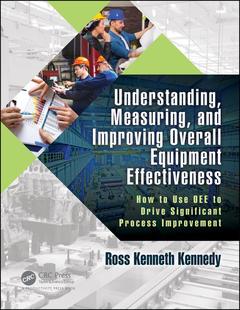Understanding, Measuring, and Improving Overall Equipment Effectiveness How to Use OEE to Drive Significant Process Improvement

Understanding, Measuring, and Improving Overall Equipment Effectiveness: How to Use OEE to Drive Significant Process Improvement explains why the Overall Equipment Effectiveness (OEE) measure was created and how it should be used.
Based on 20 years of hands on experience applying OEE at over 150 sites, this step-by-step practical guide provides templates, assessments, a comprehensive loss-analysis framework to identify all possible variables that could affect OEE, and supporting spreadsheets to measure and improve OEE. It outlines the different operational situations in which OEE can foster improvements, and the implications, before providing an easy-to-understand template for creating appropriate definitions for all the losses and a loss model.
The author explains how to calculate OEE using examples to improve performance, and then shows, in detail, how to use an OEE Loss Analysis Spreadsheet to understand all losses, set an ideal vision, and then classify losses so improvement can be approached in the most sustaining way.
Ross commenced his working career in 1970 at the Port Kembla Steelworks (12 yrs); followed by Cable Makers Australia (5 yrs) and David Brown Gear Industries (3 yrs). Over these 20 years he gained hands-on manufacturing and operational experience covering maintenance (14 years), production, operations and executive roles before moving into management consulting.
In 1985 Ross developed his passion for Lean Production following his involvement in the Value Added Management (JIT) initiative by the NSW Government. Ross quickly and effectively applied the new Lean principles and practices firstly at the CMA Foam Group Lullaby Bedding Factory while Factory Manager, then CMA’s Cable Accessories Factory as Site Manager before moving to David Brown Gear Industries as Manufacturing Manger to establish and oversee the relocation of the company from Sydney to Wollongong to a new facility set up on Lean principles and practices.
In 1989 after the new facility was well established and recognised for its leading edge improvements based on Lean, Ross was invited to join the new JIT / Lean practice being established by the Manufacturing and Operations Group of Coopers & Lybrand's International Management Consulting Practice based in Sydney.
Over the next 5 years Ross had the opportunity to work on major assignments with some of the firm’s leading Lean practitioners from USA, Canada and the UK. It was also during this time that he first came across TPM (a critical missing link in the Lean tool kit) in 1990 when he led one of the first implementations of TPM in Australasia under the guidance of John Campbell who was Partner-in-Charge of Coopers & Lybrand’s Global Centre for Maintenance Excellence based in Canada and author of the internationally recognised maintenance book – Uptime.
In August 1994 Ross established his own consulting practice specialising in TPM. He organised and chaired Australasia’s first TPM conference
Date de parution : 08-2017
21x28 cm
Date de parution : 08-2017
21x28 cm
Thèmes d’Understanding, Measuring, and Improving Overall... :
Mots-clés :
Operator Equipment Management; ideal; Autonomous Maintenance; speed; Ideal Speed; operator; Pareto Charts; management; Work Area Management; autonomous; Planned Downtime; maintenance; Process Improvement Team; planned; Daily Review Meeting; downtime; OEE Calculation; work; OEE Improvement; area; Speed Losses; Equipment Effectiveness; Cross-functional Team; Cross-functional Improvement Team; Daily Production Reports; Focused Equipment; Frontline Leaders; Pareto Analysis; Process Improvement Process; OEE; Microsoft Excel File; Production Line; Autonomous Maintenance Activity; Base Skills Analysis; CMMS



